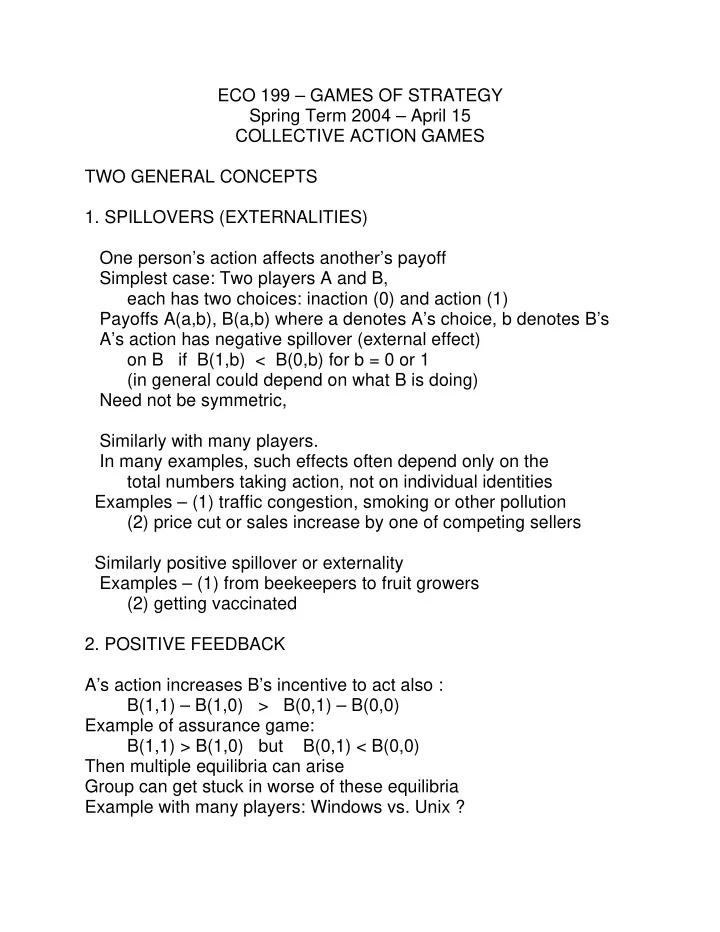

ECO 199 – GAMES OF STRATEGY Spring Term 2004 – April 15 COLLECTIVE ACTION GAMES TWO GENERAL CONCEPTS 1. SPILLOVERS (EXTERNALITIES) One person’s action affects another’s payoff Simplest case: Two players A and B, each has two choices: inaction (0) and action (1) Payoffs A(a,b), B(a,b) where a denotes A’s choice, b denotes B’s A’s action has negative spillover (external effect) on B if B(1,b) < B(0,b) for b = 0 or 1 (in general could depend on what B is doing) Need not be symmetric, Similarly with many players. In many examples, such effects often depend only on the total numbers taking action, not on individual identities Examples – (1) traffic congestion, smoking or other pollution (2) price cut or sales increase by one of competing sellers Similarly positive spillover or externality Examples – (1) from beekeepers to fruit growers (2) getting vaccinated 2. POSITIVE FEEDBACK A’s action increases B’s incentive to act also : B(1,1) – B(1,0) > B(0,1) – B(0,0) Example of assurance game: B(1,1) > B(1,0) but B(0,1) < B(0,0) Then multiple equilibria can arise Group can get stuck in worse of these equilibria Example with many players: Windows vs. Unix ?
CAUSES OF AND REMEDIES FOR INEFFICIENT OUTCOMES A’s choice: action if A(1,b) – A(0,b) > 0, inaction if < 0 Ignores addition to group payoff B(1,b) - B(0,b) Therefore we should expect to see too little of activities that have positive spillovers on others too much of activities that have negative spillovers on others To achieve group optimality, must create extra incentive (+ or – as appropriate) for person conferring spillover Within the group – 1. Some players do partly “internalize” effects on others This can reduce inefficiency 2. Enforceable binding contracts with transfer payments to create the correct incentives for socially optimal actions 3. Repeated interaction, social norms with detection and enforcement mechanisms From outside (usually government) – fines, rewards, compulsion That also create correct incentives In fact government itself can be thought of as an overall social contract Numerous case studies of group attempts to generate socially optimal outcomes from collective action games: (Provision of public goods, protection of property rights controlling depletion of common property resources, ... ) Important features of successful collective action [1] Stable and small group of players [2] System designed and monitored by local people, using better local information [3] Rules of the game (what is permitted, what sanctions on violaters, ... ) clear and well understood [4] Graduated punishments The first three conform to general ideas of repeated games Fourth goes against idea of “grim trigger strategies” but fits with the “forgiving” aspect of tit-for-tat, avoids locking in too severe a response to mistakes
AVERAGE AND MARGINAL PAYOFFS When n drivers on the road, each takes time t(n) Total time T(n) = n t(n) Example – Total time with 15 drivers = gray rectangle Time taken by 16 th driver = blue rectangle Increase in time for original 15 drivers = red rectangle Total time with 16 drivers = sum of the three rectangles If social total net payoff is maximized when 15 drivers, need congestion charge to deter extra 16 th driver = But must charge each because everyone in principle is 16 th General formula: T(n+1) - T(n) = (n+1) t(n+1) - n t(n) = t(n+1) + n [ t(n+1) - t(n) ] Marginal cost to group (increase in total time) = average cost of each member + external effect inflicted by one player on all the others For optimality, charge tax to each player = neg. spillover he creates Calculus: treating n as continuous variable: T N (n) = d[n t(n)]/dn = t(n) + n t N (n) If t(n) = a + b n, T(n) = a n + b n 2 , and T N (n) = a + 2 b n external effect = T N (n) – t(n) = b n If t(n) = c n k , T(n) = c n (k+1) , and T N (n) = (k+1) c n k , so external effect = T N (n) – t(n) = k c n k = k t(n) For traffic congestion case, can find k • 4
MANY-MALE VERSION OF BEAUTIFUL BLONDE GAME Active players: n men Background: 1 blonde, n or more brunettes Each man chooses Blonde or Brunette Payoffs: 4 if you are the only man choosing Blonde 3 if you choose Brunette and no one wins the blonde 2 if you choose Brunette and someone else wins the blonde 1 if you choose Blonde and so does at least one other Asymmetric pure strategy equilibria: exactly one chooses Blonde, the other (n-1) choose Brunette Symmetric mixed strategy equilibrium: each mixes with probabilities p for Blonde, (1-p) for Brunette Each must be indifferent between the two pure strategies given the mixed strategies of all the others Condition for equal expected payoffs: 4 * (1-p) n-1 + 1 * [1-(1-p) n-1 ] = 2 * [ (n-1) p (1-p) n-2 ] + 3 * [1- (n-1) p (1-p) n-2 ] or (1-p) n-2 [ 3 + n p - 4 p ] = 2 This can be solved numerically to find p for any given n Then we can also find probability that the blonde is not chosen at all, call it q = (1-p) n Table of solutions: n 1 2 3 4 5 6 10 20 p 1 0.500 0.268 0.183 0.139 0.113 0.064 0.030 q 0 0.250 0.392 0.446 0.473 0.487 0.516 0.543 As n increases, p goes down so fast that q goes up!
Recommend
More recommend